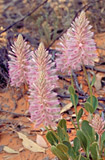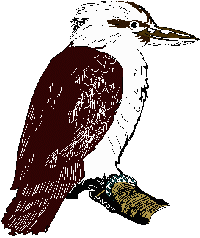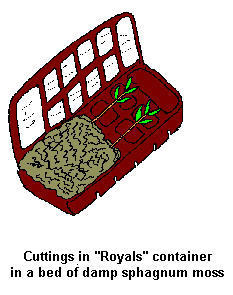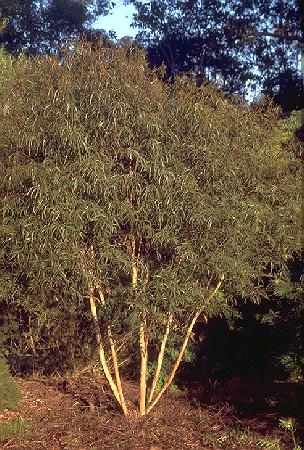|
[Front Page] [Features] [Departments] [SGAP Home Page] [Subscribe]

Short Cuts
Readers are invited to submit short items of interest about Australian plants to be included here. If submitting non-original material (eg newspaper or magazine cuttings), please also advise if the author has given permission to republish and, if not, please provide a contact address so that permission can be sought.
Short Cuts in this issue:
 Growing Ptilotus in Sydney Growing Ptilotus in Sydney
- An unusual arid - zone plant finds a home on the coast.
 Junk Food Kills Birds Junk Food Kills Birds
- Is your back garden a "fast food" attraction for the local bird population?
 An Unusual Propagation Method An Unusual Propagation Method
- All you need is ingenuity....and a packet of chocolate biscuits.
 Coppice Gardening - Adopting An Old Forestry Practice Coppice Gardening - Adopting An Old Forestry Practice
- "Chain saw therapy" finds an application in gardens.
 Germinating Seeds in Plastic Bags Germinating Seeds in Plastic Bags
- Another way to extend the plant propagation season.
 Wallabies at the Bottom of the Garden Wallabies at the Bottom of the Garden
- A bird attracting gardens is one thing....but wallabies!!!?

Growing Ptilotus exaltatus in Sydney
Ptilotus exaltatus is a spectacular small plant from the semi arid areas of Australia. It's generally regarded as difficult to grow but Joan Moore shows that it can be done.......
Following an SGAP Regional meeting where Peter Abell* spoke of the success of propagating the Ptilotus genus in trials at the University of Sydney, I purchased 25 grams of Ptilotus exaltatus seed and set about extracting the seed from the flower parts - approximately 200 seeds were extracted. The actual seed is about the same size as a poppy seed. I then placed them on the paper towel (moistened with a week solution of bleach) placed inside a plastic ice cream container.
Two days later I checked the seed and, to my surprise, several seeds had germinated. Potting was a daily ritual from then till 3 weeks later. By this time 86 P.exaltatus were placed in pots. That number decreased over the next month till I had 14 very strong plants and 21 not so strong . I planted out 14 onto a high sandy bank along my driveway, all of which are still thriving three months down the track. I progressively planted out the rest, of which 9 have survived. The strong plants are now in flower, although they are not as big as the plants seen at the Regional meeting they are very attractive.
 |
Pink mulla mulla, Ptilotus exaltatus has outstanding potential as a cut flower. Select the thumbnail image or plant name for a higher resolution image (41k).
|
Although they are getting larger as they mature, I believe the seed material sent may have been from smaller forms. I attribute the low success rate before and after germination to the immaturity of the seed. The seed germinated on the paper towel seemed unable to find its correct stem depth. Some plants damped off seemingly due to being too deeply planted , others were obviously planted too high judging by the colour of the base of the stem and the fact that the plant tendered to grow along the ground before growing upwards. At the moment I am experimenting with placing the seed directly into pots. The seed needs to be planted on or near the surface as it has insufficient energy to grow through the potting medium.
I intend experimenting further with P.exaltatus and others from the genus and am hoping to naturalise them in my garden as seed collection without flower destruction is difficult.
* Dr Peter Weston was mentioned in the original article in error.
From the November 1996 issue of "Calgaroo", newsletter of the Parramatta and Hills Group of the Society for Growing Australian Plants.
[ Return to Index ]

Junk Food Kills Birds
Many people like to put out food trays for birds, but is it a good idea? Jenny Adams doesn't believe so....
It is not necessary to kill birds with kindness.
Many of us love to have birds visiting our gardens. But is distressing to see misguided members of the public
'helping' birds by providing bread, seed, sugar water and honey. These are all junk foods for birds and sadly introduce disease and distress to the birds.
Why Not Feed Birds Artificial Food?
Salt present in bread and processed foods is not present in bird's natural diet.

Fat is also limited in natural diet. Kookaburras eat lizards, frog's insect's etc, all low in fat unlike the processed meat often fed to them.
Bird seed, is often not the type of seed that the birds would naturally eat. Seed left out in damp conditions rots, grows mould and introduces disease to the birds.
Spread of disease by concentrating food and birds in large numbers in one place.
What happens when you stop? Birds often become dependent on the provision of food and lose the ability to forage for themselves particularly if they have been reared to this type of feeding by the parent birds and not taught how to find food in a natural circumstances.
Illness - 'Runners' are created by a virus spread from bird to bird and which causes loss of flight feathers and therefore prevents flying. These birds become easy prey for cats and foxes. They also can get a bleeding disease, which is caused by a lack of pectin normally obtained from the pectin in the nectar of flowers and is not in honey or sugar. Viral, fungal and bacterial diseases can result in many birds dying a slow and painful death.
What are Native Birds For?
Pollination - Many Australian plants need birds to fertilise them so that they can produce seed. Without the birds, reproduction of native flora species can be severely affected. (European Bees do not do this job)
Dispersal of fruit - Many Australian plants are dependent on birds to spread their seed, often seed viability depends on passing through a bird's gut.
What Can Happen?
Behaviour changes
- Aggression and increased stress through different species feeding together.
- Birds can often be observed squabbling like rats around feeding tables.
- They also become aggressive toward humans.
- Scavenging for unnatural food (like camp sites and resorts)
Feral Birds - If you live in a city area the only birds you sometime attract are feral birds, rats and cockroaches.
Wants of people versus the needs of the environment - It is unfair to treat creatures as though they are there for our own pleasure only without considering the welfare of the animals. Often people have a mistaken belief that birds need supplementary feeding. This is an old European idea where plants and insects shut down over the long cold winter. In Australia, plants do not shut down and there is plentiful food all year round. Lots of native flora flower in winter - the birds are adapted to the provision of natural food and move around as necessary.
Ecosystem effects - The Australian environment is intricate and complex, and has evolved over millions of years. Much disruption is caused by habitation loss and agriculture. What little remains of our natural heritage need to be protected and not further disrupted by inappropriate treatment of fauna.
Attracting birds to your garden
The best way is by planting native locally indigenous plant species and providing a simple birdbath in a place that is safe from cats. Plant species should include understorey plants like native grasses and ground covers shrubs and trees. The more diverse the flora the more fauna species will be attracted in your garden. Plants should be planted close to create a dense understorey to make birds feel safe - untidy gardens with lots of logs and dead branches is what most fauna are attracted to. Most birds eat a balanced diet; 90% eat insects plus nectar, seed or fruit.
Jenny can be contacted at redfrog@zip.com.au or treefrog@zip.com.au
[ Return to Index ]

An Unusual Propagation Method
Take one box of chocolate marshmallows - throw away the contents and what you have left is a mini glasshouse. Maria Hitchcock wipes the chocolate from the corner of her mouth and explains....
 
Here's one for the Chocaholics.
You will need to buy a packet of Arnotts Royals. They are chocolate covered marshmallow puffs, which come in a plastic hinged container.
Pig out on the biscuits but keep the container. It makes an excellent cuttings frame. Fill the lower half of the container with damp sphagnum moss. Prepare two cuttings and place them on top, one on each row of biscuit holes. Add more damp moss over the lower part of the stems and then close the container, securing with three rubber bands.
Stand the container up in a margarine or ice-cream container. You can probably fit three Royals container into one ice-cream container. Leave the cuttings inside the house in a semi-shaded cool spot. Inspect every week or so for sign of roots. These should be visible through the plastic.
Note: Dry Sphagnum moss can be purchased in small bags. It contains a natural fungicide, so your cuttings shouldn't damp off. The Royals container should be tightly shut, so that it forms a mini hothouse. I would recommend this method for people who have no professional set-up but would like to grow the odd cutting or two.
You could probably fit more than two cuttings into a container, but be careful as you don't want to crowd them with too much foliage. It's also a method that children could use.
I promise, I don't work for Arnotts!
From the June 1997 issue of the newsletter of the Correa Study Group of which Maria is the leader. For the benefit of our overseas readers, Arnotts is a famous old Australian biscuit manufacturer....now majority owned by an American company.
[ Return to Index ]

Coppice Gardening - Adopting An Old Forestry Practice
Multi-stemmed mallee eucalypts are ideal for smaller gardens but often grown on a single trunk in cultivation. Diana Snape looks at coppicing to achieve the mallee effect.
The Macquarie Dictionary tells us that a coppice (or copse) is a wood, thicket, or plantation of small trees or bushes. The verb to coppice is to cut, as of Eucalyptus trees, to encourage numerous slender trunks to regenerate from the root-stock.
There should be much potential in applying the technique of coppicing to achieve attractive effects in garden design. This might mean coppicing just a single tree, or a group of them to obtain a small 'plantation'. We have tried using it with four species of eucalypts - two single trees, two in groups, with varying degrees of success.
 |
|
| This Eucalyptus scoparia has developed an attractive multi- stemmed habit after being cut back to within 300mm of the ground. |
|
The first was Eucalyptus calycogona (gooseberry mallee). This was one of a group of several different mallees we thought would grow well as small trees in the garden, providing a fine light screen and canopy. In fact they liked garden conditions too well and grew rather tall and rangy. When we tried coppicing a pair of E.calycogona. they were not really happy about it and the few trunks which grew tended to be rather floppy. Another of the group of mallees is E.behriana (bull mallee), the mallee which occurs naturally closest to Melbourne. It has five or six trunks growing from a large lignotuber and so it needed no coppicing, though it's said to respond well ('Encyclopaedia of Australian Plants').
Coppicing one E.gunnii (cider gum) annually worked well for several years but the beautiful glaucous new growth proved too tempting for numerous caterpillars/insects. Cutting back had to be done each year if we wanted the silvery juvenile foliage. We don't use sprays; sometimes we were away or not on guard; sometimes the birds let us down. The combination of producing new growth each year and fighting insect attack weakened the tree, so E.gunnii and we eventually gave up the struggle. It did look lovely at its best but not when it was suffering. If we'd had a larger number of these trees, not just one, it may have been less of a problem (or possibly not) but I think the process itself seemed rather too unnatural.
We planted a group of three E.Ieucoxylon (yellow gum) in the front garden, then later decided there was one more than we really wanted and cut one back to ground level. After a little while it sprouted and we cut it back again. After this happened a few times we decided we should let be a tree so determined to grow.It's now a beautiful little tree with three or four slender trunks - an asset in a small garden - looking very natural with the other two more advanced trees . It's interesting to note that E.Ieucoxylon is the only one of these four eucalypts which is indigenous to Melbourne (as it is to many areas).
Just recently it was necessary for us to cut back a single tree of E.macrandra (long-flowered marlock) when the forked trunk was badly split during a storm. We decided to take it back to its large lignotuber. It's now starting to sprout generously, so we're waiting with keen anticipation to see how it goes. (We've put wire over it temporarily to discourage possums, which seem to think any delicate new shoots are put in the garden especially for them.)
Have you tried (or seen interesting examples of) coppicing of eucalypts (or other genera)? Please tell us about it. As it imitates one natural and characteristic response of mallees to fire, it's a very Australian trait.
From the February 1998 issue of the newsletter of the Garden Design Study Group of the Society for Growing Australian Plants. Diana is the leader of that Group.
[ Return to Index ]

Germinating Seeds in Plastic Bags
Pregermination of seeds prior to planting out has a number of advantages for larger seeds. Jan Sked describes one variation of the method.
In my early years in the Society, I heard about seeds of grevilleas being successfully germinated in plastic bags and decided to give it a try.
My method was to place three handfuls of peatmoss in a clear plastic bag (267 x 381mm), add approximately half a cup of water, then a quantity of the required seed and shake the lot together to mix (rather like flouring chops for cooking). Then I blew into the bag to expand it and secured the neck with a twist tie.
The bag was then labelled with the species name and date of sowing, and attached to the clothesline under my house by the twist-tie. This was in a position where there was plenty of light, but no direct sunlight.
Two bags were filled in that way and attached to the clothesline. They were inspected every day or two. With clear plastic bags the first shoots and roots can be seen as they form. As soon as they showed, I potted them into 75mm tubes of the sand-peatmoss (3 to 1) mix for growing on. Some plants damped off, but this can usually be prevented by spraying with a fungicide.
The first seeds I tried were Grevillea pteridifolia (seeds were washed in a strainer) and G glossadenia (seeds were nicked with a razor blade to expose a little of the white embryo inside). The former germinated in 4 weeks, the latter in 3 weeks. Not all seeds germinated at once.
The bag of Grevillea pteridifolia produced 59 plants over a period of 3 weeks, a much higher percentage than I anticipated (about 99%). Over a period of 4 weeks G.glossadenia produced 7 plants from 10 seeds planted.
Inspired by this success, I decided to try other types of seed. The following seeds were all planted in September, which seems to be the optimum time for such activity. Whether it is as successful at other times of the year I am not sure. Fine seeds, such as some members of the Myrtaceae family, were not used, as the seedling are too fine to handle.
| Species |
First Germination
| Success
(%)
| Treatment
|
| Acacia farnesiana |
2 weeks |
50 |
Boiling water |
| Banksia marginata |
2 weeks |
90 |
None |
| Banksia spinulosa |
6 weeks |
50 |
None |
| Barklya syringifolia |
4 weeks |
50 |
Boiling water |
| Corymbia setosa |
1 weeks |
70 |
None |
| Cupaniopsis newmannii |
2 weeks |
100 |
None |
| Eucalyptus miniata |
1 weeks |
50 |
None |
| Flindersia australis |
2 weeks |
90 |
None |
| Grevillea glauca |
2 weeks |
100 |
Nicked |
| Kennedia rubicundra |
3 weeks |
100 |
Boiling water |
| Lambertia formosa |
4 weeks |
75 |
None |
| Leea indica |
8 weeks |
100 |
None |
| Omalanthus nutans |
1 weeks |
100 |
None |
| Petalostigma triloculare |
5 weeks |
100 |
None |
| Pittosporum phylliraeoides |
3 weeks |
70 |
None |
| Planchonella australis |
3 weeks |
100 |
None |
| Senna odorata |
3 weeks |
70 |
Boiling water |
|
From the March 1998 issue of the "Bulletin", the newsletter of the Queensland Region of SGAP.
[ Return to Index ]

Wallabies at the Bottom of the Garden
Joan Tucker has a problem that most urban dwellers never experience....
but would probably like to!
Our house is built on a steep slope facing the north west. There are quite a few very tall eucalypts to the front and on each side of the garden (the type that go up for 20 metres before they branch), and of course there are many younger trees coming up as well. The trees are a mixture of grey box, woolly butt and ironbark. The land has been logged, grazed and cleared for development leaving two small areas of regenerating bush, the rest of the area being covered with Kunzea ambigua, groundsel (probably Senecio linearifolius) native grasses, sedges, pimelea and of course black wattle and hop bush. We imagined the garden we would create: exotics around the house and natives everywhere else.
There were no houses in sight, bushland all around and we were delighted to find that there were wallabies and kangaroos in abundance. We subsequently found that we had goannas, at least four types of lizard, possums, echidnas, rabbits, foxes and lots of birds. The Eastern Grays passed us by and moved on to kikuyu and the fruit trees planted by a neighbour, the echidna only dug up one plant, the rabbits stayed away, the lizards and possums (surprisingly) were garden friendly, and the foxes kept a discreet distance.
We planted all our exotics, poppies, azaleas, geraniums, chrysanthemums, roses and also grevilleas, bottlebrushes, wattles, correas, and many more exotics and natives and WE DREAMED! What we didnít dream is that each morning we would find more leafless, flowerless plants. As some of our plants grew we would look out each morning and see a family of red necked wallabies happily grazing in the middle of the garden. There was Mamma, Poppa, two smaller wallabies and a baby in Mammaís pouch. They waved happily to us each evening as they grazed on our treasured plants. Early in the morning we would see a solitary brown figure nibbling away at the flowers and leaves. That was the swamp wallaby.
 
We tried spraying with various nasty concoctions both commercial and homemade including quassia chips, chilli, and a rather nasty fishy spray made from Thai fish sauce, but as we watered regularly or it rained these soon washed off. We put duck wire over the plants but discovered that any reasonably intelligent wallaby will sit on the wire and the plants will poke through to be eaten. Wire guards and plastic surrounds merely act like fodder bags and a little head easily fits in. Eventually we built a post and wire fence around part of our land. The fencer assured us that mesh 12 x 6 In (300 x 150mm) with a fence height of 3ft 7in (1100mm) would keep the blighters out, but HE WAS WRONG! It kept out the red necks but not the swampies. They came under and through. We blocked all the holes at ground level but they continued to come through the mesh and we would have to check the fence regularly to make sure there wasnít another hole.
Every night there would be two or three in the garden and they ate all the buds off the large flowered grevilleas, bottlebrush and the exotics as well as the pimeleas.The hop bushes were stripped of leaves and the branches torn down. Lucerne hay mulch proved to be very tasty. We bought bales of hay and fed them outside the fence in the vain hope that it might stop them coming into the garden. It proved to be a good entree, but they still dined on our plants so we eventually stripped feeding them and started to plant plants they didnít like. Even then it was difficult, because they might touch a plant for six months, then suddenly it would become delectable.
I maintain the garden in front of the house and Laurel does the back. I would grow plants quite successfully and so Laurel would plant them only to find that suddenly they became delicious. Laurelís garden is closer to the bush and mine is closer to the road. Finally we attached duck wire to the large mesh with staples and a staple gun and left about 30cm flat on the ground held down by rocks (of which we have plenty) and this has been successful. NO MORE WALLABIES!
Comparing notes with others on the estate we find that those with dogs have no problems with wallabies as long as the dogs never go on holiday. Those with cats (us) have no problems with rabbits. I am compiling a list of natives that wallabies wonít eat, however there are no guarantees that they will not eat them one someone elseís land. It may be just that they eat the choicest plants first. A word of warning - donít ever plant poppies! They will find every one, nibble them almost to the ground, leave them to grow and then return. They constitute a wallaby feast.
We miss our wallabies, but unfortunately it was either wallabies or garden so we now must be content with seeing them at a distance outside the fence.
From the March 1998 issue of the newsletter of the South East NSW Group of the Society for Growing Australian Plants.
[ Return to Index ]

[Front Page] [Features] [Departments] [SGAP Home Page] [Subscribe]
Australian Plants online - June 1998
The Society for Growing Australian Plants
|